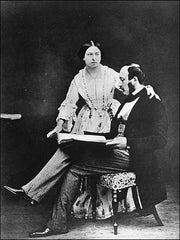History of Victorian Mourning Jewelry
 Compass Rose Jewelry's line inspired by Victorian mourning jewelry, which has an interesting cultural and natural history. Mourning jewelry of the late Victorian era (1860s – 1880s) represents not only the love, loss and grief of Queen Victoria as a human being – but of the experiences of people across Europe and the Americas experiencing loss of loved ones on the teetering edge between the old world and the modern era. A time bridging an older world of European tradition and a new world of innovation and technology – the Victorian Era was steeped in layers of social convention, personal stories and political change.
Compass Rose Jewelry's line inspired by Victorian mourning jewelry, which has an interesting cultural and natural history. Mourning jewelry of the late Victorian era (1860s – 1880s) represents not only the love, loss and grief of Queen Victoria as a human being – but of the experiences of people across Europe and the Americas experiencing loss of loved ones on the teetering edge between the old world and the modern era. A time bridging an older world of European tradition and a new world of innovation and technology – the Victorian Era was steeped in layers of social convention, personal stories and political change.
Queen Victoria, in her decades of reign, influenced politics, fashion and social convention of the country, and indeed much of the world. Utterly devoted to her husband of more than two decades, Victoria was distraught after his death in 1861. Victoria and Albert’s was a marriage based truly on deep respect and romantic love, though was firmly contextualized within the constraints of the time. Though it took Victoria several years to share responsibilities of ruling with Albert as she was rather controlling and precise in her dedication to the responsibilities of the throne. However, Albert’s expert administrative abilities and grasp of global political shifts at work surpassed Victoria’s, though neither of them imagined the how much the world would change in their children’s generation.
 Victoria came to rely on Albert heavily for political advice and decision-making. Albert was member of a minor house of the Sax Coburgh and Gotha line – a smallish German-speaking Duchy (Germany did not exist as a unified country until 1871). The British people were not excited about a “foreign” king, so Victoria would rule as Queen and Albert would be her Prince Consort. Because Victoria’s mother was also a member of the Sax Coburgh line, Victoria was also fluent in German, which was the prmary language used between Victorian and Albert and their children in their private household.
Victoria came to rely on Albert heavily for political advice and decision-making. Albert was member of a minor house of the Sax Coburgh and Gotha line – a smallish German-speaking Duchy (Germany did not exist as a unified country until 1871). The British people were not excited about a “foreign” king, so Victoria would rule as Queen and Albert would be her Prince Consort. Because Victoria’s mother was also a member of the Sax Coburgh line, Victoria was also fluent in German, which was the prmary language used between Victorian and Albert and their children in their private household.
Though both the Queen and Albert were fascinated by the emerging array of technologies it was Albert who was involved with the organization of the 1851 World Fair and Great Exhibition – home of the famous Crystal Palace. Victoria understood herself as a guardian of morals and an example to the realm, which by the middle of her reign included Great Britain, The Republic of Ireland, and India. It was at this exhibition that Albert received one of the first commercially available keyless-wind watches – a new jeweled design of watch that sparked a watch chain and fob trend that lasted several generations.
 As a personal embodiment of the royal line and the Empire, Queen Victoria observed and emphasized the reserved traditions of the time. Intimacy, sex and indeed the acknowledgement of being in a physical body, were ideas her highness preferred not to dwell upon. Tightly constricted in tight corset and expansive crinoline hoop skirts, the 1850s-1870s mid Victorian fashion very specifically circumscribed the ideals of gender, class and fashion. She supported the introduction of the new science of ether anesthesia in childbirth, which had been used in the birth of her seventh and eighth children. However, Queen Victoria was adamantly against breastfeeding, which seemed to her backwards and overly bodily, and was horrified when several of her daughters wanted to nurse their own children.
As a personal embodiment of the royal line and the Empire, Queen Victoria observed and emphasized the reserved traditions of the time. Intimacy, sex and indeed the acknowledgement of being in a physical body, were ideas her highness preferred not to dwell upon. Tightly constricted in tight corset and expansive crinoline hoop skirts, the 1850s-1870s mid Victorian fashion very specifically circumscribed the ideals of gender, class and fashion. She supported the introduction of the new science of ether anesthesia in childbirth, which had been used in the birth of her seventh and eighth children. However, Queen Victoria was adamantly against breastfeeding, which seemed to her backwards and overly bodily, and was horrified when several of her daughters wanted to nurse their own children.
 When Albert died in 1861, Victoria’s world came crashing in around her. She went into a state of mourning that lasted forty years. In this historical moment, we are reminded that the great Monarch was also a person. Upon Albert’s death, Victoria collapsed to the floor, then gathered up the youngest child, Beatrice, only four, and wrapped her in Albert’s nightclothes and lay their until dawn.
When Albert died in 1861, Victoria’s world came crashing in around her. She went into a state of mourning that lasted forty years. In this historical moment, we are reminded that the great Monarch was also a person. Upon Albert’s death, Victoria collapsed to the floor, then gathered up the youngest child, Beatrice, only four, and wrapped her in Albert’s nightclothes and lay their until dawn.
As so eloquently stated in Victoria’s Daughters, “When Albert died, not only did the normal physical and emotional love that passes between spouses vanish with him, but so did the one person over whom this queen did not want to reign.”
 So complete was Victoria’s state of mourning, she withdrew almost completely from politics for several decades and brought the whole country into mourning with her. Until her death, she wore black widows weeds, demanding that her children did the same. Consumed by her grief, she did not tolerate laughter or joviality from her children. Casual expressions of missing their father were disallowed - seen by the Queen as being disrespectful to his memory. Victoria's relationships with her children (and indeed her own mother) were complicated – a somewhat difficult combination of love, disappointment, respect and criticism. Intimacy was not a strong suit of the Victorian age. The family palaces, especially Albert’s private rooms at the family home at Balmoral, Scotland became mausoleum-like shrines to Albert’s memory. Nothing in the Prince Consort’s rooms was altered. Victoria ordered that fresh clothes and warm shaving water was changed by valet’s daily, waiting patiently as if he would, at any moment walk into the room. The Queen – a monarch and figurehead, was clearly a woman overwhelmed by grief.
So complete was Victoria’s state of mourning, she withdrew almost completely from politics for several decades and brought the whole country into mourning with her. Until her death, she wore black widows weeds, demanding that her children did the same. Consumed by her grief, she did not tolerate laughter or joviality from her children. Casual expressions of missing their father were disallowed - seen by the Queen as being disrespectful to his memory. Victoria's relationships with her children (and indeed her own mother) were complicated – a somewhat difficult combination of love, disappointment, respect and criticism. Intimacy was not a strong suit of the Victorian age. The family palaces, especially Albert’s private rooms at the family home at Balmoral, Scotland became mausoleum-like shrines to Albert’s memory. Nothing in the Prince Consort’s rooms was altered. Victoria ordered that fresh clothes and warm shaving water was changed by valet’s daily, waiting patiently as if he would, at any moment walk into the room. The Queen – a monarch and figurehead, was clearly a woman overwhelmed by grief.
 As political change and upheaval shifted loyalties and boundaries in Europe, Queen Victoria continued to mourn in her private world. In addition to her strict black mourning dresses, the Queen wore only black mourning jewelry. Despite her absence from public life, she mandated that only mourning jewelry could be worn in court until about 1880.
As political change and upheaval shifted loyalties and boundaries in Europe, Queen Victoria continued to mourn in her private world. In addition to her strict black mourning dresses, the Queen wore only black mourning jewelry. Despite her absence from public life, she mandated that only mourning jewelry could be worn in court until about 1880.
Because of its somber and dark appearance, Queen Victoria took to wearing black jet jewelry, from Whitby, in Yorkshire. As a limited and fairly difficult medium to work with, jet was expensive. It’s a hard material, requiring skilled craftsmanship to avoid breakage during carving. Black glass became a popular alternative, as it was more available, less expensive, and easier to work with. Other common materials for mourning jewelry used between 1860 and 1900 were Onyx, Vulcanite, Gutta Percha, and Bog Oak.
Mourning was the backdrop of the time. The entire late Victorian era has been described as “the Cult of Mourning” where mourning entered social conventions, fashion and indeed infused most aspects of life. Indeed, throughout the 1860s, Queen Victoria was not alone in her Grief.
 In the United States, the Civil War raged, and women from both North and South donned mourning clothes. President Lincoln was shot – throwing the already unstable nation into further uncertainty. This was a moment in time when the photography became more commercially available, when the faces of people could be captured in light and shadow instead of pen and ink. This new form of visual memory converged with the development of longing and sorrow as a way of life. Lockets, hair jewelry, and love tokens abounded as mothers and wives held on to these keepsakes of hope or remembrance.
In the United States, the Civil War raged, and women from both North and South donned mourning clothes. President Lincoln was shot – throwing the already unstable nation into further uncertainty. This was a moment in time when the photography became more commercially available, when the faces of people could be captured in light and shadow instead of pen and ink. This new form of visual memory converged with the development of longing and sorrow as a way of life. Lockets, hair jewelry, and love tokens abounded as mothers and wives held on to these keepsakes of hope or remembrance.
Mourning required strict protocol. The first year was full mourning, where only black clothing and jewelry was permissible. After that, half-mourning colors including as gray, mauve and purple were suitable. Victorian mourning conventions have influenced the aesthetics of many subcultures over time, including gothic, steampunk, punk, s&m, fantasy and anime.
Shop the Mourning Jewelry Collection
A NATURAL HISTORY OF JET
JET: "deep black lignite," mid-14c., from Anglo-Fr. geet, O.Fr. jaiet "jet, lignite" (12c.), from L. gagates, from Gk. gagates lithos "stone of Gages," town and river in Lycia.
As "a deep black color," also as an adjective, attested from mid-15c.
 Jet is a type of petrified wood, produced through a natural process of pressure and water applied to trees from the ancient Araucariaceae family. The hard jet found at Whitby England dates to the early Jurassic period, and is perfectly suited to jewelry making. Like amber, jet generates static electricity when rubbed. Hard jet is petrified in salt water and soft jet is petrified in fresh water conditions. Hard jet is petrified in salt water and soft jet is petrified in fresh water.
Jet is a type of petrified wood, produced through a natural process of pressure and water applied to trees from the ancient Araucariaceae family. The hard jet found at Whitby England dates to the early Jurassic period, and is perfectly suited to jewelry making. Like amber, jet generates static electricity when rubbed. Hard jet is petrified in salt water and soft jet is petrified in fresh water conditions. Hard jet is petrified in salt water and soft jet is petrified in fresh water.
Jet was popular in Neolithic and the early Bronze Age and survived into Roman expansion into Britain. Rings and bracelets made of jet have been unearthed in ancient pre-Roman sites on the British Isles. Along with jet adornments, archaeologists found many small round disks that puzzled them for decades until in they realized by the Late Victorian era that these were the remaining centers of lathe-turned jet jewelry.
A stunning example of Roman-era jet jewelry on the British Isles was discovered in 1901 in the grave of a high-class mixed-race woman who lived in 4th century York. This is the so-called “Ivory Bangle Lady” is named for the bracelet made of elephant ivory (probably North African) and Whitby jet (from the North of Yorkshire) found in her grave. This woman embodies the mixing of cultures and traditions through empire and expansion that have taken place for centuries and millennia.
 Jet bracelets from Hallstatt culture have been found in graves in the Black Forest and other Celtic sites throughout mainland Europe. Because no natural sources of jet are known near the Rhine Valley where many artifacts have been found dating to pre-Roman times, these finds are seen as evidence of trade connections between Britain and settlements on the mainland.
Jet bracelets from Hallstatt culture have been found in graves in the Black Forest and other Celtic sites throughout mainland Europe. Because no natural sources of jet are known near the Rhine Valley where many artifacts have been found dating to pre-Roman times, these finds are seen as evidence of trade connections between Britain and settlements on the mainland.
Jet was known as Gagates or Gagates Lapiz by the scholars on antiquity. Pliny the Elder describes both the geology and uses of Jet in his 37-volume Encyclopedia of Natural Historypublished in 77 AD. Pliny describes jet sources in Lycia, Anatolia, (modern Turkey) along the banks of the Gages River. From this description, it is clear that the difference between hard and soft jet was not understood. The Romans also used soft jet , to paint pottery, claiming it made it less breakable. Lycia figures into the Homeric tales of the Trojan War, where two Lycian brothers are described as allies of the Trojans.
The Romans seem to have mostly used jet for medicine and fuel rather than adornment. Pliny documented antiquarian beliefs in jet’s ability to heal epilepsy, toothaches, and to drive away rodents. In a translation of Pliny’s own words:
CHAP. 34.—GAGATES: SIX REMEDIES.
Gagates is a stone, so called from Gages, the name of a town and river in Lycia. It is asserted, too, that at Leucolla the sea throws it up, and that it is found over a space twelve stadia in extent. It is black, smooth, light, and porous, differs but little from wood in appearance, is of a brittle texture, and emits a disagreeable odour5 when rubbed. Marks made upon pottery with this stone cannot be effaced. When burnt, it gives out a sulphureous smell; and it is a singular fact, that the application of water ignites it, while that of oil quenches it. The fumes of it, burnt, keep serpents at a distance, and dispel hysterical affections: they detect a tendency also to epilepsy, and act as a test of virginity. A decoction of this stone in wine is curative of tooth-ache; and, in combination with wax, it is good for scrofula. The magicians, it is said, make use of gagates in the practice of what they call axinomancy; and they assure us that it will be sure not to burn, if the thing is about to happen as the party desires.
The 1867 Natural History of Gems mentions the Magi’s use of jet for Axinomantia (Axinomancy) – a method of divination requiring stones that heated but did not melt or burn placed on an axe blade submersed in flame. In Pliny’s Book 28, chapter 5, Gagates Lapiz is misidentified is agate, causing the association of agate with Axinomancy in addition to the original jet. Jet was the preferred material for Victorian mourning jewelry throughout the 19th century.
Get lost in some of the original source documents:
- Natural History of Gems (1867)
- Dictionary of Greek And Roman Antiquities (1843)
- Pliny’s description of Lycia and use of Jet: Chapter 36 of Natural History
See more historic examples of mourning jewelry on our Pinterest page
